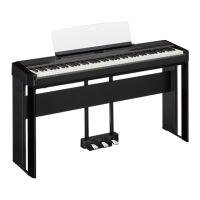72
P-515 Owner’s Manual
Connections
For information about location of these connectors, refer to “Panel Controls
and Terminals” on page 12.
1[] (USB TO DEVICE) terminal
This terminal allows connection to USB flash drive or a smart device, such as
an iPhone/iPad, using the USB wireless LAN adaptor. For details, refer to
“Connecting USB Devices” on page 74 and “Connecting to a Computer/Smart
Device” on page 75.
2 [AUX IN] jack
You can connect the headphone jack of a portable audio player to the
instrument’s [AUX IN] jack, letting you hear the sound of that audio player
through the built-in speakers of the instrument.
Connectors
Before connecting the
instrument to other
electronic components, turn
off the power of all the
components. Also, before
turning any components on
or off, make sure to set all
volume levels to minimum
(0). Otherwise, damage to the
components, electrical
shock, or even permanent
hearing loss may occur.
For details on [PEDAL UNIT]
terminal and [DC IN] jack, refer
to “Panel Controls and
Terminals” on page 13.
There are two different types of
USB terminals on the
instrument: [ ] (USB TO
DEVICE) and [USB TO HOST].
Take care not to confuse the
two terminals and the
corresponding cable
connectors. Be careful to
connect the proper plug in the
proper direction.
When this instrument’s [AUX
IN] jack is connected to an
external device, first turn on the
power to the external device,
and then to the instrument to
avoid possible damage.
Reverse this order when you
turn the power off.
The instrument’s [MASTER
VOLUME] setting affects the
input signal from the [AUX IN]
jack.
Use audio cables and adaptor
plugs having no (zero)
resistance.
Instrument
Phone plug (stereo mini) Phone plug (stereo mini)
Portable audio player
Audio cable
Headphone jack
Audio signal

